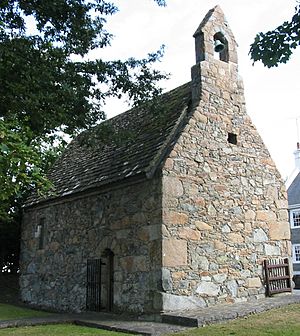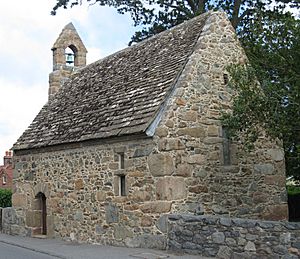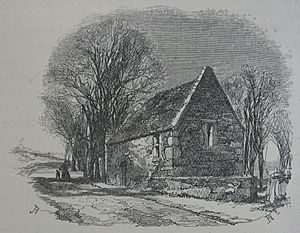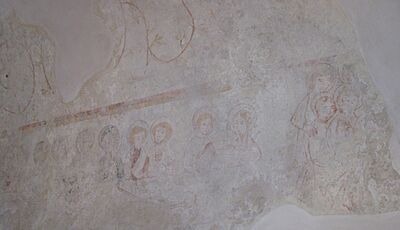Chapel of St Apolline, Guernsey facts for kids
The Chapel of St Apolline is a very old and special building in Saint Saviour, Guernsey. It was built in the 1300s and has been used for prayers and services for over 600 years. This historic chapel looks almost the same today as it did centuries ago. It is a protected building and an important historic monument.
Contents
The Chapel's Long History
How the Chapel Started
A man named Nicholas Henry built this chapel in 1392. He lived nearby at La Perelle manor. He built it as a "chantry chapel," which was a special place for priests to pray for the souls of certain people. Nicholas Henry dedicated the chapel to Saint Apolline.
Who Was Saint Apolline?
Saint Apolline was a woman who lived around A.D. 249 in a place called Alexandria. Christians were being treated badly there. Sadly, her jaw and all her teeth were hurt. She then bravely went into a fire and became a martyr, meaning she died for her beliefs. She was later made a saint in A.D. 300. Today, she is known as the patron saint of dentists. People used to pray to her to help with toothaches.
Early Mentions of the Chapel
The chapel was first mentioned in official papers in 1394. King Richard II of England wrote about "the chapel of Saint Marie de la Perelle." Later, in 1452, it was called "the chapel of Our Lady, of La Perrelle, also known as the chapel of Sainte Appolyne."
Changes Over Time
The chapel was owned by different people through the years. During the Protestant Reformation, the old Catholic ways changed. In 1563, a special group gave the chapel to Thomas Effart, a leading Protestant. The building then fell into disrepair. Luckily, it was saved from being completely destroyed because people started using it as a stable for animals.
Some valuable items were probably hidden or taken from the chapel during this time. Later, some of these items were found again. These include a stone statue from the 1300s, a cross from the 1500s, a silver container for wine or water, two candle holders, and a bell clapper.
Saving the Chapel
In 1873, the government of Guernsey, called the States of Guernsey, bought the chapel and some land for £120. At that time, it was being used as a barn for cows. This was a very important step because it was the first time Guernsey bought a building just to protect its history.
The chapel was fixed up in the 1970s. Workers added heating under the floor to help with dampness. They also put on a new roof, fixed the bell tower, and added new lights. However, the damp problem continued. In 2003, more plans were made to protect the chapel and its old paintings. These new improvements, like better air flow, have helped a lot.
Inside the Chapel
Chapel Features
The inside of the chapel is one single room. It measures about 8.2 meters long and 4.2 meters wide. It has a pointed, arched roof. There is enough space inside for about 14 people to sit.
Ancient Paintings
You can still see parts of the original paintings from the 1300s inside the chapel. On the south wall, there is a painting that shows the Last Supper. Another painting might show Jesus washing the feet of his followers, called the Apostles. These paintings were likely done very quickly because the plaster dried fast.
Building Materials
The walls of the chapel are very thick, about 0.75 meters (or 2.5 feet) wide. The stones used to build the chapel came from different places. Most of the stone came from nearby Cobo, on the west coast of Guernsey. Some local stone from Perelle and stone from Icart, in the south of Guernsey, were also used. Even stones from the distant Chausey islands have been found. Two special blocks of Caen stone, from Normandy in France, were used in the north window.
Visiting the Chapel
The Chapel of St Apolline is open every day for people to visit. It is used as a quiet place for prayer and thinking. It is a simple and peaceful spot for anyone to visit and reflect.
There is also a beautiful stained glass window in the north wall. It shows Sainte Apolline and an angel holding a tooth.
Protected Status
The Chapel of St Apolline, along with its boundary walls and the land around it, was officially named a Protected Monument on March 16, 1938. Its reference number is PM204.
See also
- List of churches, chapels and meeting halls in the Channel Islands





